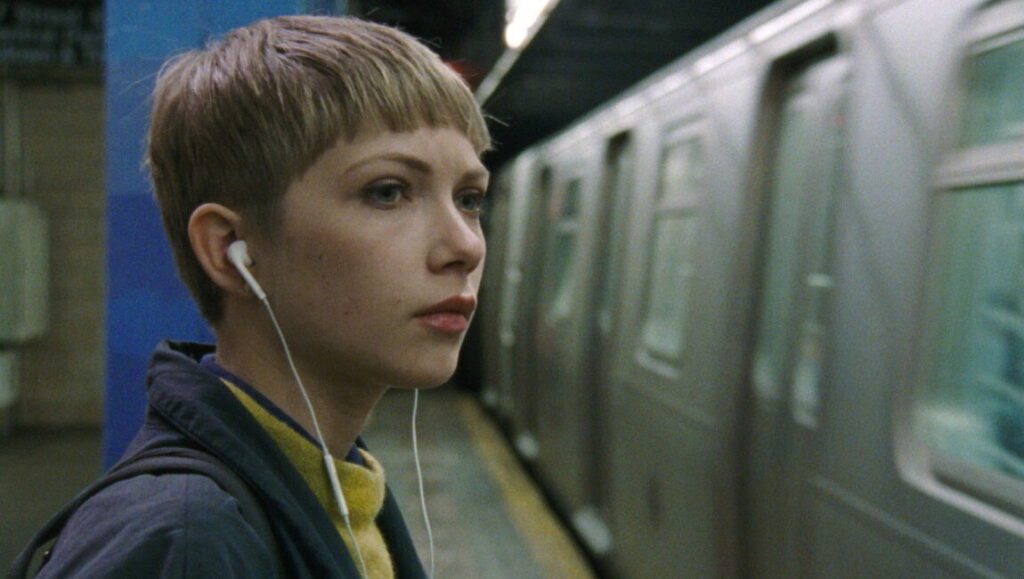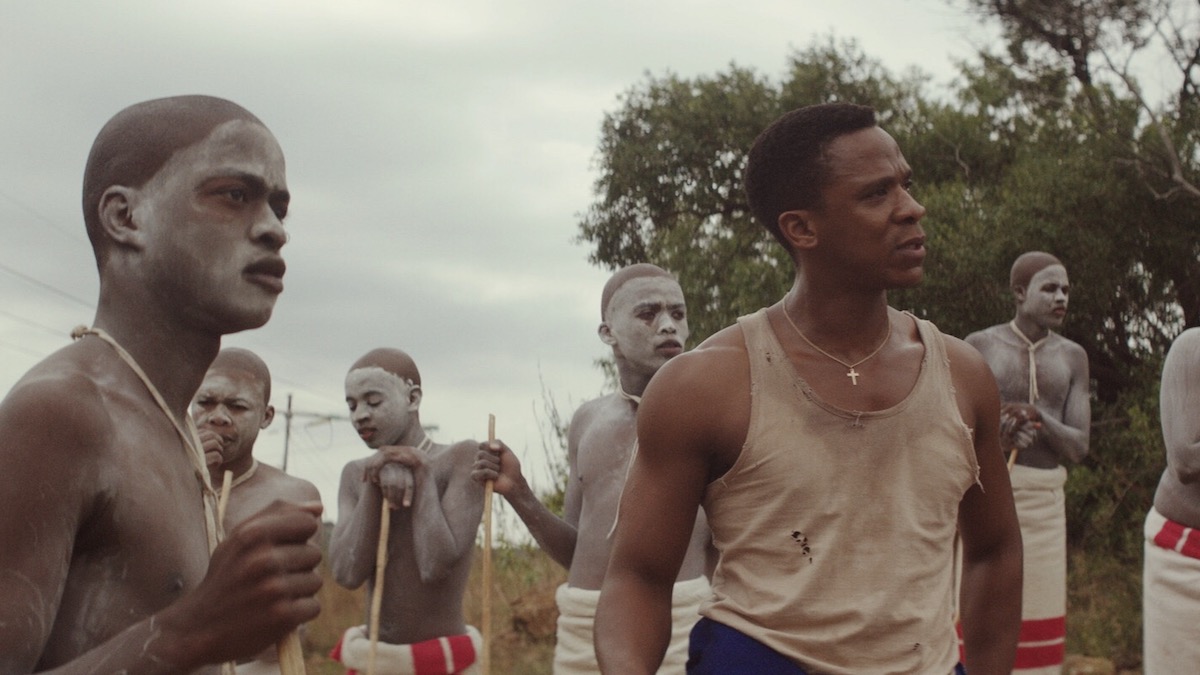The 46th edition of New Directors/New Films concluded this past Sunday with Dustin Guy Defa’s much-discussed Person to Person. Our final dispatch from the festival takes a look at Guy Defa’s “pleasantly low-key” film; tries to parse the intensions of Alain Della Negra and Kaori Kinoshita’s docu-drama hybrid on a UFO-worshipping cult; revisits Angela Shanelec’s film festival whatsit The Dreamed Path, as well as another oddity of “macro- and micro-fictions” from independent Thai filmmaker Anocha Suwichakornpong; and plenty of others. Check it all out below.
Many ND/NF entries have demonstrated an admirable scale in their ambitions, but few have had the confidence to do so as unassumingly as Dustin Guy Defa’s pleasantly low-key Person to Person. This feature expansion of short by the same name, true to its title, tracks the sprawling, loosely connected misadventures of its varied cast across New York City. Two reporters investigate a suicide or possible homicide; a zealous LP collector looks to obtain a rare Charlie Bird LP; and a girl argues with her girlfriend about the new boyfriend she’s been seeing. Sharply observational and lightly comic, Defa’s is the kind of film that’s bound to be overshadowed at a larger festival, since its subtle pleasures often threaten to shade into inconsequential. Granted, it doesn’t ride the line of purposeful awkwardness as adroitly as it needs to, sometimes coming across as labored or amateurish. But Defa demonstrates genuine promise, both in his rhythm (an extended, placid chase scene is a highlight), and in the way he draws light, gossamer threads between the micro-stories, allowing their thematic heft to emerge naturally. By the end, a lingering sense of sadness permeates; the various characters are stuck in the familiar, unsure of exactly how to proceed. If there’s one thing certain, it’s that, with Person to Person, Defa marks himself as a talent to watch. Lawrence Garcia
Julia Murat’s Pendular is filled with impressive compositions: it opens with its central couple — credited as He (Rodrigo Bolzan) and She (Raquel Karro) — jointly and joyously bisecting a large warehouse’s upper-story with a roll of red tape. This space, which will serve as both home and studio for the lovers (He an abstract sculptor, She a modernist dancer) acts as a simple visual metaphor for their relationship: issues of emotional encroachment and loss of independence define the characters in Murat’s sparse script. Unfortunately, little happening here expands this idea — with an affectively forceful performance and some captivating choreography from Karro providing the exceptions. The film is undermined by its fundamental inequity: She is gifted a far richer, more expressive arc, leaving her partner feeling wrongly underdeveloped. If Murat had sought to reflect deeper on her exploration of space or her characters’ art, something bolder and less reliant on tangible characterization could have emerged; instead, He is directionless, She is indulgent — so an art critic friend tells him, so a newspaper review tells her. Murat clearly seeks to externalize this couple’s turmoil, but beyond a Footloose-esque cathartic dance (after which She literally strips herself bare), we’re left with few incisive moments amid much tedium. Luke Gorham
Starting out as a bit of meta-commentary on a notorious massacre, Anocha Suwichakornpong‘s By the Time It Gets Dark quickly and deliberately questions its own point of view by filtering it through multiple layers of macro- and micro-fictions, ultimately suggesting the inability of art to truly process experience and trauma. In a strong resemblance to Apichatpong Weerasethakul’s Cemetery of Splendour, planes of existence are layered one on top of the other, and frequent visual allusions to disparate images share the same space…a filmmaker interviewing a survivor of a student protest-turned-atrocity; a series of vignettes set at a tobacco farm; a magic mushroom trip; a cleaning woman at a hotel…elements of all of these stories are revealed to be manufactured, in one way or another intermediary devices through which histories and societies are cataloged. Matt Lynch
As InRO‘s Lawrence Garcia put it, the best thing about film festivals is seeing something that will completely surprise you — and he and I definitely agree that The Dreamed Path is surprising. Angela Schanelec‘s film opens with a couple — Kenneth (Thorbjörn Björnsson) and Theres (Miriam Jakob) — in a forest in Greece. Kenneth gets a phone call from his sick parents, and decides that he must return home to take care of them. Theres then gets a teaching job in Germany. Soon the film changes location and time, moving about 30 years later, and to Berlin. We begin to follow a brand new couple, Ariane (Maren Eggert) and her husband David (Phil Hayes), lovers who as well suffer from an eventual falling out, and with the same level of non-descript drama that affected the film’s first romance. The four characters end up interlocked with one another, though Schanelec doesn’t initially seem interested in developing why each person has gotten to this point. Rather, her focus seems more on the hypnotic mood of her film; her long takes don’t feel purposelessly ponderous, but more intentionally telegraph an uncertainty. It’s refreshing to see a filmmaker in this year’s ND/NF lineup who wants to use their film in a genuinely questioning fashion, and not just as a showcase for their rigorous technique. The Dreamed Path can often be a baffling experience, one that doesn’t start to reveal its complexities until its second half — when the overall structure begins to make more sense. Up until this point, Schanelec refuses to state any intention, much to the chagrin of many who’ve sat through her film. But the prize for being a patient viewer in this case is one of the strangest and most unique features to grace the festival circuit this year. Paul Attard
It’s hard to imagine French director Alain Guiraudie going for mainstream appeal, but if he did, the result might look something like Jérôme Reybaud’s road trip movie Four Days in France. In what’s surely a coincidence, Reybaud’s film bears some superficial similarity to Guiraudie’s Staying Vertical: A restless protagonist, Pierre (Pascal Cervo), takes to the road with a manuscript and has various odd encounters of a sexual nature and otherwise; numerous POV shots from the car set the film’s peripatetic rhythm; Pierre even has a run-in that strips him of his belongings, just like the wayward writer in Staying Vertical. But those similarities only underline how wan Reybaud’s vision is by comparison — how sharp, interesting detail can easily come across labored in a different context. That’s not to say Reybaud brings nothing to the table: his film works as a tour of France, not just in terms of its lush landscapes, but also of its people, particularly those that live in the French countryside. (Pierre’s Parisian identity is brought up multiple times.) The fact that Pierre leaves behind a lover (Paul, played by Arthur Igual), who then decides to take off after him, also means that there’s an underlying tension here, even as the interest inherent in any given scene varies wildly. And although the film is digressive and overlong (at 145 minutes), its conclusion—which brings together two strands long kept apart — is touching all the same. L Garcia
John Trengove’s The Wound is a thematically blunt but visually dynamic film, one built around intimate, observational camerawork and an integrity of character development. Impressively choreographing a delicate dance between tradition and modernity, while allowing his camera to mirror that dichotomy through some interesting incongruities (aqua-hued running shoes worn with tribal garb and body paint), Trengove imbues The Wound with a mythic aura, an inspired counterpoint to its tender interpersonal underpinnings. With the rural Xhosa people and their ceremony of initiation into manhood as the backdrop, Trengove could could have phoned-in a exoticized coming-of-age story here, but instead, The Wound smartly subverts those expectations throughout, most notably by focusing on the years-old parasitic relationship between two of the adult mentors and their psychological motivations for always returning to a mountain and their custom. Primarily concerning itself with differing notions of masculinity, across generations and within an traditional community, The Wound also shows out with its trio of vulnerable, expressive performances. If the end hits a bit heavy-handedly (underlining a fundamental paucity of narrative innovation), it isn’t enough to undermine the affecting, aching beauty, nor Trengove’s obvious filmmaking chops. L Gorham
Ala Eddine Slim’s The Last of Us is the type of film that’s inevitably described as “spare,” “rigorous,” and “conceptually bold.” Unfolding over a distended 94 minutes, without a single word of dialogue, the film follows two (unnamed) immigrants attempting to cross from northern Africa into Europe. Along the way, one of the two men is captured, hauled off and never seen again; the other continues on. After stealing a motorboat boat, which subsequently breaks down, the remaining man finds himself stranded in an island forest, at which point the film begins to shift into a more mystical, magical-realist mode. There’s an inherent political (and social) interest built into Slim’s chosen subject, which is enhanced by both his background in documentary filmmaking and Amine Messadi’s appealing (often low-light) cinematography. But owing to the film’s (over-)liberal use of negative space — both formal and conceptual — The Last of Us fails to resonate beyond the theoretical, remaining strictly, and frustratingly, skeletal. Slim’s strenuous symbolism overwhelms any human specificity: There’s some appealing detail in the margins, particularly when the documentary interest of his subject comes to the fore, but the overall experience is akin to watching someone laboriously draw obscure symbols on a page for ninety minutes. However gorgeous or necessary those symbols may be, there’s nothing interesting about their presentation. The final shot suggests transcendence, of a sort: the man (or Man) returns to his primordial roots. But suggestion is as far as the film goes; the image disappears from view and then—like the film as a whole—promptly evaporates from memory. L Garcia
“I hope we’ll have fun and party, that’s why I’m here!” This is what Lilly (Laure Calamy) tells an excited crowd of French retreaters in The Happiness Academy. The crowd is there courtesy of the Raelian Church, a religious institution steeped in the belief that aliens have created Earth — the only difference between Lilly and the rest of them is that she’s played by an actress while her audience is not. Part drama and part documentary, Happiness Academy observes the believers as they try to better their lives — in between being fed propaganda by the church’s leader and having extravagant pool parties. Directors Alain Della Negra and Kaori Kinoshita never cast a blanket judgment on these people, but instead use Lilly as a conduit to explore the more petty reasons some of them may be there (i.e., just to have wild sex). The criticisms feel half-cocked though, never developed or specific enough to have an impact beyond that of mud-slinging. The Raelians don’t come off as much different from any other religion, or at least one that’s based heavily on, er, UFO-worship; they’re often just regular people with different beliefs. It’s hard to then really understand which direction the film wants to go in: It occupies a weird, warmed-over middle ground, generally not particularly that critical, but pretty ugly on the occasions that it tries to be. PA










Comments are closed.